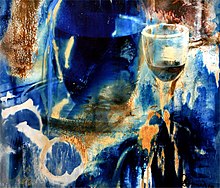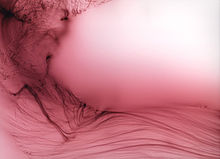Abstract photography
Abstract photography is a specialty of photography . The term was coined by Alvin Langdon Coburn in 1916.
history

Already in the early phase of abstract photography at the beginning of the 20th century, it was claimed that one could basically only speak of abstract photography if one did without cameras altogether in order to record only the effects of light on light-sensitive substances (so-called "apparatusless photography"). The "Vortographs" Alvin Langdon Coburns , the "Schadographs" Christian Schads or the "Rayograms" Man Ray managed without a camera. The production process of the photo was thus reduced, whereby there were several options:

- In the case of cliché verre (glass cliché printing), a glass plate is painted or coated with soot or the like and then a drawing is scratched, like a drypoint etching . After that, the glass plate serves as a kind of negative, so that here it is abstracted from the camera, but not from the negative.
- With the photogram , objects are placed on the photo paper, which then leave traces in the form of white shadows when exposed, so that even a negative is dispensed with here.
- In contrast , the luminogram , in which photo paper is processed directly with light (lighting design), does not only use a camera and negative, but also objects to be illustrated.
- In the chemigram , compounds of chemicals on photosensitive paper ultimately lead to the development of visible shapes, so that you get a fixed trace of a controlled interaction between light and photosensitive material.
- The chemogram is created on black-and-white photo paper, including a negative imprinted during the creation process. Partly in the darkroom, but also in the daylight laboratory, with the simultaneous use of colorless chemicals, which then only react in color in the shift, together with the initially latent photo, and can be designed accordingly.

After 1930, two main directions of abstract photography emerged: a constructivist and a surrealist. For example, Laszlo Moholy-Nagy's “New Bauhaus” in Chicago had its own laboratory for lighting design from 1937, where luminograms and staged images were created in the tradition of constructivist imagery as free compositions of geo- and stereometric basic forms.
Parallel to the dominance of abstract painting after the Second World War, there was also a renaissance of constructivist photographic art and biomorphic or gestural photographic abstractions, which, however, largely came to a standstill with the triumph of Pop Art .
Current trends
Despite the diversity of today's positions in abstract photography, there is fundamentally between more conceptual approaches, which primarily reflect their own conditions of creation or the “process of image generation” (Kröner 2011) and to that extent do something like “basic photographic research”, and more aesthetically oriented approaches who focus on the implementation and further development of the classical understanding of abstract painting with the help of various photographic means. The latter see themselves as photographic painting or pictorial photography, which does not differ fundamentally from abstract painting in terms of its concept, but which, due to its specific photographic methods and the consistency of its approach, certainly asserts itself, a unique one and not with painterly means to create affordable forms of new abstraction.
The chemograms created by Josef H. Neumann in the mid-1970s , in which photography and abstract painting are combined within one work, form an interface between the two conceptual approaches . In contrast to photo painting, the colors of a chemogram are not applied externally, but are created purely photomechanically in the photographic layer during the creation process.
With the two best-known representatives of contemporary abstract photography, Thomas Ruff and Wolfgang Tillmans , it is first noticeable that they cannot be tied to abstract photography and a certain style. Rather, they ask on a theoretical-conceptual level about the truthfulness of photography or the image itself and deal with this topic systematically in the form of series of images, which in their entirety do not differentiate between representational and abstract - in turn related to the postmodern painting of Gerhard Richter .
Ruff's approach is therefore characterized by an “openness in the use of a wide variety of sources, photographic suggestions, starting materials and processing methods” (ibid.). The starting point of his “substrate pictures” are, for example, “ manga comics ”, which were broken down into their pixelated individual parts on the computer until the originally banal motif resulted in streams of blurring colors that reveal the “substrate” of the picture. And with his "New JPGs", Ruff also addresses digital image processing and transmission (ibid.)
Wolfgang Tillman's current turn to abstract photography is very similar, which Kröner characterizes as “scientific” as well as “photo-scientifically motivated search for traces of photography” (ibid.) Like the cameraless processes described above, his works are created as direct exposures of photo paper or emphasize how the "Lighter" series enhances the object character of photography by presenting monochrome photo prints folded in a Plexiglas box (ibid.).
Other well-known representatives of photographic art working with the means of abstraction are u. a. Stefan Heyne , Miriam Böhm , Marco Breuer , Peter Braunholz , Christiane Feser , Torsten Warmuth , Michael Wesely and Stefanie Seufert .
Individual evidence
- ^ Coburn 1979, Kellein / Lampe 2000
- ↑ Messner 2010
- ↑ Hannes Schmidt: Comments on the chemograms by Josef Neumann. Exhibition in the photography studio gallery of Prof. Pan Walther. in: Photo press. Issue 22, 1976, p. 6.
- ↑ Kröner 2011
- ↑ Hanselle 2009
literature
- Christiane Feser: Latent Constructs. Distance Verlag, 2012, ISBN 978-3-942405-99-7 .
- S. Heyne: Speak To Me. Hatje Cantz, 2012, ISBN 978-3-7757-3277-2 .
- AL Coburn: The Future of Pictorial Photography. In: W. Kemp (Ed.): Theory of Photography. 1979.
- Ralf Hanselle: Abstract Photography. New viewing habits in photo art. In: young art. 2/2009.
- Ralf Hanselle: The autonomy of photography. In: art value. No. 10, 2012.
- G. Jäger (Ed.): The art of abstract photography. 2002, ISBN 3-89790-015-7 .
- G. Jäger ao: Concrete photography. 2005.
- T. Kellein, A. Lampe (Ed.): Abstract photography. 2000.
- M. Kröner: Form, fragment, formation. Current trends in abstract photography. In: Kunstforum International. Volume 206: New Abstraction. 2011.
- F. Messner: Pictorial photography. In: Kirk Sora: cosmonauts paradise. 2010.
- F. Messner: Abstract Photography. In: Abstract Photography. 2011.
- W. Tillmans: Abstract Pictures. 2011, ISBN 978-3-7757-2743-3 .
- Lambert Wiesing: What could 'abstract photography' be? In: Lambert Wiesing: Artificial Presence. Studies on the Philosophy of the Image. Suhrkamp, Frankfurt am Main 2005, ISBN 3-518-29337-0 , pp. 81-98.
Web links
- Gottfried Jäger: Abstract Photography
- Society for Abstract Photography
- Essay by Ralf Hanselle
- Website for the exhibition STEFAN HEYNE. NAKED LIGHT. The exposure of the infinite in the Städtische Galerie Dresden - art collection
- Josef H. Neumann: Publication records for the chemograms
